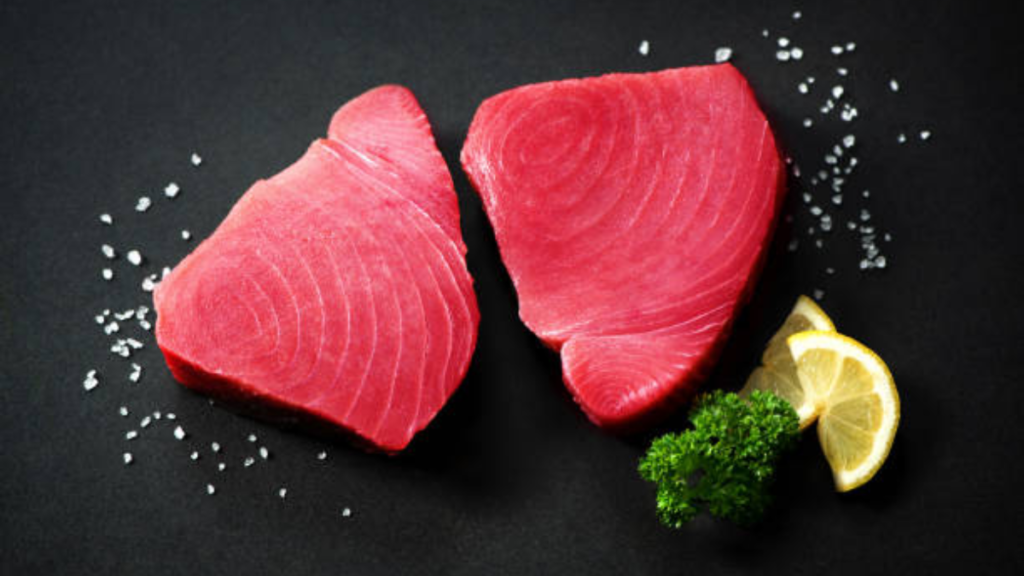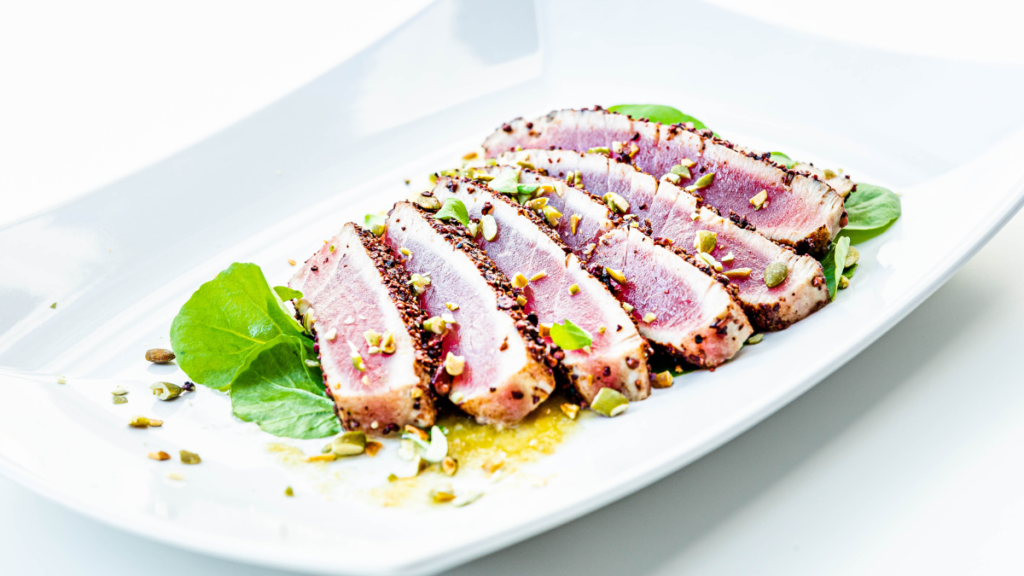If you want to know how to cook tuna steak, in this article, you will get all the crucial information about cooking tuna steak. Tuna is a saltwater fish found in habitats ranging from the Atlantic Ocean to Indonesia. Skipjack, also known as “light” tuna, and Albacore, also known as “white” tuna, are the most well-known tuna species in the United States. Albacore tuna is the only type that can be legally sold as “white meat tuna.” Tuna is one of the most popular seafood species on the planet. Tuna is exceptionally nutritious, in addition to its abundance and meaty flavor.
Due to its high oil content, tuna has meaty, firm flesh and a rich, intense flavor. Because tuna is oily, the flesh spoils faster than other fish, so buy it as soon as possible. When you buy tuna, it will already be skinned, boned, and cut into portions, making it a straightforward fish to prepare because there is very little prep work required other than seasoning – and it cooks very quickly.
Tuna Nutrition Facts
Here’s a table of Tuna Nutrition Facts based:
| Nutrient | Amount per Serving (100 grams) | % Daily Value* |
|---|---|---|
| Calories | 116 | 6% |
| Total Fat | 1 g | 2% |
| – Saturated Fat | 0.3 g | 1% |
| Cholesterol | 38 mg | 13% |
| Sodium | 48 mg | 2% |
| Total Carbohydrate | 0 g | 0% |
| – Dietary Fiber | 0 g | 0% |
| – Sugars | 0 g | |
| Protein | 25 g | 50% |
| Vitamin D | 12.7 mcg | 64% |
| Calcium | 4 mg | 0% |
| Iron | 1.3 mg | 7% |
| Potassium | 330 mg | 9% |
*Percent Daily Values are based on a 2,000-calorie diet. Your daily values may be higher or lower depending on your calorie needs.
What is Exactly Tuna?
Tuna (also known as “tunny”) is a type of fish that belongs to the Thunnini tribe of the Scombridae family (the mackerel family). The tribe comprises five genera and 15 species, most of which belong to the Thunnus genus.
The bluefin tuna, with its red fleshy loins that are sliced into steaks or cut into small strips for sushi, and the albacore tuna, which becomes pale and flaky when packed in a can, are probably the two most important types of tuna from a culinary standpoint.
Tuna migrate around the world’s oceans and can swim up to 75 miles per hour. The Atlantic bluefin tuna (Thunnus thynnus), the most prominent member of the tribe, can weigh up to 1,500 pounds and maintain a body temperature higher than the water temperature.
Varieties of Tuna:
While there are 15 species of tuna and numerous subspecies, you are most likely to encounter four main varieties.
1. Albacore Tuna
- This is the most common variety, with the lightest flesh and mildest flavor.
- It’s often canned and sold as albacore white tuna, and it’s more expensive than light-chunk tuna.
2. Bluefin Tuna
- Fresh tuna connoisseurs have a wide range of options.
- The flesh is dark red to almost purple and has more fat and flavor than most other varieties.
- This is the most potent variety, with many fish weighing 1,000 pounds.
- Most of the bluefin catch is shipped to Japan and sold as sashimi.
3. Skipjack Tuna
- is a low-cost tuna variety that is typically canned in light chunks.
- It is the most miniature variety, rarely growing more prominent than 25 pounds, and has the most intense flavor and fat content.
- This fish, also known as arctic bonito or Aku, is known for jumping and skipping across the ocean’s surface. Katsuobushi is the Japanese term for dried bonito.
4. Yellowfin Tuna
- Also known as ahi, this fish is less expensive than bluefin, but it’s as good.
- Yellowfin tuna is widely available in grocery stores and fish markets.
- It has a deeper pink color and a more robust flavor than albacore.
- In poke bowls and sushi rolls, sashimi-grade ahi is used. It’s also suitable for searing and grilling, and it can be canned.
How to Cook Tuna Steak?
Ingredients
- Two line-caught tuna fillets, 2 cm thick
- Olive oil
- Sea salt flakes and cracked black pepper
- Squeeze of lemon
Method
- If you’re looking for those desirable char marks, then you need the help of a griddle pan.
- As with pan-frying, drizzle olive oil over each steak and season with salt and pepper.
- Heat the skillet over high heat and cook the tuna for 1½ mins on each side before removing it from the pan. Drizzle with a little more oil, squeeze the lemon, and rest for a few mins before serving.
- You can rotate the fillets halfway through cooking on each side if you want a criss-cross pattern on top.
What to Eat with Tuna Steak?
Tuna is a challenging and adaptable fish that can withstand some intense flavors. It works well in various Asian cuisines because it can stand up to various spices. Please keep it simple and serve with new potatoes and a fresh vinaigrette. You could also serve roasted vegetables with a delicious salsa verde.
Tuna also goes well with fresh citrus fruits and aromatic herbs, which are prevalent in Mediterranean countries. Ceviche, in which the fish is cooked in the acid of citrus fruit, is another popular way to eat tuna. Check out our tostadas and tuna ceviche recipe.
What does Tuna Taste like?
Tuna has a variety of flavors depending on the species, the form it takes, and how it is prepared. However, some common characteristics can be found in all of its forms.
When raw, rare, or packed in oil, tuna is meaty and dense, with an almost creamy melt-in-your-mouth texture. Fresh tuna has a sweet and saline flavor; when preserved, it has a strong fishiness, but the sweetness and creaminess return when mixed with mayonnaise, cheese, or cream.
Fresh Tuna vs. Preserved Tuna
While there are many different types of tuna, the main distinction is between fresh and preserved tuna. Tuna, like any other fresh fish, is highly volatile. Once caught, it must be transported to market as quickly as possible (and kept on ice aboard the ship until arriving at port) and handled with extreme caution.
The clock starts ticking as soon as the fish is taken out of the water, and it only gets faster as the fish is broken down and sliced into portions at a retail outlet. Nothing beats a perfectly fresh tuna steak grilled rare with squeezed lemon and extra-virgin olive oil drizzle. This, however, is not always possible.
When people were lucky enough to catch a giant tuna, they couldn’t always eat it all, so they developed techniques for preserving it in salt, smoke, or covered in olive oil in a closed container dating back to ancient times. Fresh and canned tuna are two different ways of saying the same thing: they can both be delicious and satisfying but in very different ways.
Where to Buy Tuna?
Commercially canned tuna can be found in the condiment section of almost any supermarket.
High-quality artisan-level tuna from Southern Italy or Spain, packed in extra-virgin olive oil with herbs or other seasonings, can be found in gourmet food shops or specialty online sites, as can be smoked or salted tuna.
When it comes to fresh tuna, go to a reputable fish supplier with a high turnover rate, and trust your eyes: fresh tuna will appear shiny and translucent rather than grayish matte and dull.
Storing Tuna
The type of tuna makes all the difference once again. Tuna in cans can be kept for three to five years in a cool, dry place.
If well wrapped in plastic, kept in the fridge, and not opened and exposed to air, smoked or salted tuna can last for six to nine months, possibly even longer.
Fresh tuna steaks wrapped in plastic can be kept in the refrigerator for up to two days, but the quality will deteriorate with each passing hour, especially if you plan to eat it raw or rare.
Conclusion
Tuna can be grilled, broiled, skewered, ground into burgers, seared, and sliced over a salad or casserole. Not cooking it at all, as in Japanese sushi and sashimi, Italian carpaccio, or South American ceviche, is one of the best ways to prepare it. Tuna also holds up well to smoking or salt curing and canning in oil or water for tuna fish salads, tuna melts, and tuna casseroles.
The best tuna is saved for raw dishes like sushi and sashimi. Fresh tuna should be cooked medium-rare at home, seared quickly over high heat, preferably on a grill. If you can’t eat medium-rare tuna, at the very least, avoid overcooking it.
Tuna cooks much faster than beef, and the lower fat content makes the chef’s job more difficult. Because tuna is easily overcooked, some extra caution is required. Always purchase tuna steaks that are at least 1 inch thick. Grill your tuna over a high heat source or sear it in a hot pan.



